Vol 5 No. 6 TROPIC LIGHTNING NEWS February 9, 1970
Index
'Crushing' Blow to Enemy
CAV "Drops In' on Weapons Cache
By SP4 JOE O'ROURKE
CU CHI - The men of Alfa Troop, 3rd Squadron, 4th Cavalry are stopping the
enemy by breaking piggy banks, stopping presses, and taking all the firepower
away from him they possibly can.
The Raider's latest find was in the Boi Loi Woods while on a reconnaissance
in force mission accompanied by Sheridan tanks and Armored Personnel Carriers.
"One of the Sheridan's went over a hidden concrete slab," said Sergeant Dan
Yoban from San Jose, Cal., a Track Commander. "It gave way and somebody looked
inside the hole and stopped the patrol."
INSIDE THE TUNNEL complex was one of the largest enemy weapon's caches found
in recent weeks. Included in the find were 10,000 rounds of 30 caliber ammo, 33 CKC rifles, three cases of TNT, fifteen 122mm rockets, twelve 107mm rockets, and
five 57mm and 75mm recoilless rifle rounds.
"Whew!," exclaimed Yoban, "I'm glad we won't have to worry about that stuff
any more."
Alfa Troop's recent ammo find compounds a list of large caches the 3/4 Cav
began finding in mid-November of last year, when the Raiders' came up with a
cache of 2,125,000 piasters.
"We were on a patrol in the Mushroom near Fire Support Hunsley when we
spotted a breathing hole in a clump of suspicious-looking bushes," said Sergeant
Lonnie Dotson of Tacoma, Wash., "We started poking around and pretty soon found
a large tunnel and bunker.
INSIDE THE BUNKER were three NVA who were forced out with some grenades.
Private First Class Alvin Hite of New Orleans, La., said, "We started passing
out bags, but it wasn't till we started going through everything that we found
the money. When I saw how much there was I thought, `Wow! We're all rich.'"
Documents which were also found in the bunker indicated that the three NVA
were high-ranking officers who were going to use the equivalent to 20,000
dollars in U.S. currency to buy 500,000 liters of rice.
Their next find, an enemy printing press complete with type and copies of the
latest propaganda, also took place in the Boi Loi Woods, 15 miles northwest of
Cu Chi. The Raiders were checking out some bunkers they had blown.
STAFF SERGEANT KERMIT W. Garrett of Jamestown, Tenn., said, "I saw a big
mound of dirt and a hole that looked like an air vent. We searched the area
around looking for a trap door, but couldn't fine one, so we decided to dig
around a little."
After digging through dirt, sawing through logs, and picking through cement
the Raiders finally made it into the hole. Against the walls of the huge
bunkers were stacks of trays filled with printing type, bottles of ink and
gallons of dye, and the real prize, the 1,500 pound press.
The Raiders had no trouble removing the ink and the type, but it took a
"slick" from the 25th Aviation Battalion to remove the huge press.
Then it was Charlie Company working in a combined operation with the 773
Regional Forces from Bau Trai, who became the spoilers. The combined forces
came up with a weapons' cache that included 309 CKC rifles.
| Personal hygiene is one thing a man cannot pass the buck on in Vietnam. If you don't stay clean you may find yourself with some kind of disease. It's much easier to get than it is to get rid of. Body powder is readily available so try to stay dry. Keep clean dry socks on as often as possible. Brush your teeth or at least rinse your mouth out with a little water after every meal. |
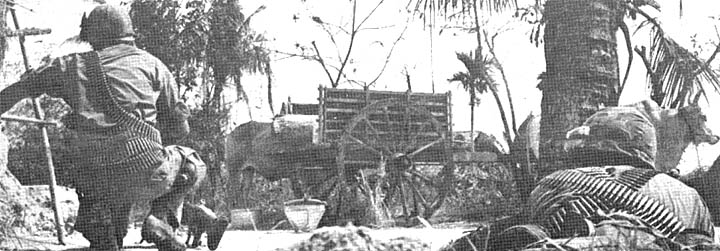 |
| HIT IT! - A Warrior machine gunner and ammo bearer hit the dirt after an enemy soldier was spotted on an operation in the Citadel area. During the day's operation, Delta Company of the 2d Battalion, 12th Infantry found an enemy platoon leader who revealed the location of a 75 mm recoilless rifle and an ammunition cache. (Photo by SP4 Jeff Hinman) |
'Every Inch Was Fought For'
Slow Boat To Cu Chi and a Four Year Stay
The 25th Infantry Division's 2d Brigade arrived by ship in Vung Tau January
30, 1966, moved to Bien Hoa and then, in a 600-vehicle convoy headed for Cu
Chi. The Cu Chi area was an enemy stronghold in those days and Tropic Lightning
soldiers spent the month of February clearing the base camp area under constant
harassment by enemy snipers. Staff Sergeant Lewis Krichton of Sherrystown, Pa.,
was with the 25th when it arrived. Now, after four years, he's going home.
By SP4 GREG STANMAR
CU CHI - The GI who complains that liver was served on the jet that brought
him over or that once here the PX didn't have the stereo he wanted will get
little sympathy from one Golden Dragon sergeant.
"When we first got here," said SSG Lewis E. Krichton, Sherrystown, Pa., "it
was on a boat. At Cu Chi the only thing they had in the way of facilities was a
command tent in the middle of what an optimistic person would call a base camp."
Krichton moved into Cu Chi with the Second Brigade on Feb. 15, 1966. He left
this month, nearly four years later.
"What I first saw of Vietnam was the shoreline from our troop ship anchored
offshore. I saw that shoreline for four days. For some reason it took that
long before we landed."
After landing at Vung Tau the brigade made its way to Cu Chi.
"This place looked like a good spot on our maps. Trouble was," said Krichton,
"the VC must have had the same maps because there were plenty of enemy around."
Sweeps by the First and Second Brigades in critical areas as the Filhol
Plantation, Trang Bang and Go Dau Ha brought the situation under control.
"An infantryman then didn't have the firepower we have now. Every inch was
fought for."
Meanwhile back at the base camp, perimeter security was provided by the 1st
Squadron, 5th Mechanized Infantry tracks.
"It might be misleading to say we had two brigades here," said Krichton.
"Actually it was only six undermanned battalions."
When asked about the division's success in the last four years, Krichton
replied, "Just the fact that you can walk around the base camp without getting
shot is something if you think back to '66. The area around here is well under
control and the people like us."
Each time Krichton went home on leave, he said, "my father asked me if I was
going back to Nam. When I said I was he called me crazy. I doubt if he'll
believe I'm coming home for good now."
Kills 12 Enemy
Armor, Air, Arty Join
By SGT. WALLY BAKER
NUI BA DEN - Men from Headquarters Company Dreadnaughts and air and
artillery support killed 12 enemy just before ending their day's
reconnaissance-in-force mission.
A visual air reconnaissance team working in the area with Headquarters
company 2d Battalion, 34th Armor spotted 15 enemy soldiers moving at the base of
the "saddle" that separates Nui Ba Den from Nui Cau mountain. Flying low to
observe, the aircraft received small arms fire from the enemy location. At this
time the Cobra gunship (the other half of the team) flying high above, dove in
and sprayed the enemy area with rockets and mini-gun fire. Dreadnaught tanks
and armored personnel carriers then directed their fire on the enemy location.
Ninety mm cannon fire and .50 caliber machine guns covered the area with their
immense fire power.
As the armormen were unloading their fire the VR team spotted three more
enemy in the area. Artillery was called in as the Dreadnaughts pulled back.
Later, sweeps uncovered the 12 dead enemy.
Radar Goes To the Dogs
PB KOTRC - Captain William H. Schular Jr. of Ripon, Wis., commander of
Charlie Company 2d Battalion, 27th Infantry Wolfhounds working out of Kotrc,
this week attested to the thoroughness of his radar team.
Schular said that one dark night earlier this month, the radar alerted him
that something, possibly a jeep, was moving down a road near Kotrc toward his
perimeter. Schular alerted tower lookouts and an ambush patrol set up near the
read.
A search with starlight scopes revealed nothing but the radar said the object
was still moving directly toward the night position. Schular readied his
artillery.
After a couple of moments of suspense, the mystery was solved. The night
position reported that a dog had just wandered into its location.
"That just proves that this radar is extremely thorough," said Schular with a
grin.
Page 2 TROPIC LIGHTNING NEWS February 9, 1970
Decorated
| SILVER STAR | |
| SGT William Richard, Co B, 2d Bn, 12th Inf | |
| DISTINGUISHED FLYING CROSS |
|
| CPT Richard Goldsmith, HHC, 2d Bn, 22d Inf 1LT Rolvin C. Lentsch, Co A, 25th Aviation Bn 1LT Rudy Parris, Co D, 3rd Sqdn, 4th Cav 1LT Ray M. Thomann, HHC, 1st Bde |
CW2 Robert T. Bobo, Co D, 3rd Sqdn, 4th Cav WOl Joseph C. Wasmond, Co A, 25th Aviation Bn CSM Albert Pough, HHC, 1st Bde |
| BRONZE STAR FOR HEROISM |
|
|
MAJ Ronald L. Baker Jr., HHC, 1st Bn. (M), 5th Inf MAJ Carl R. Quickmire, HHC, 2d Bn, 12th Inf CPT John Michell, Co E, 2d Bn, 27th Inf CPT Robert J. Zonne Jr., Co A, 4th Bn (M), 23d Inf CPT William C. Beaver II, HHC, 4th Bn (M), 23d Inf 2LT Richard L. Aliulis, Co B, 2d Bn, 12th Inf 2LT Larry E. Crawford, Co B, 2d Bn, 12th Inf 2LT Samuel Hargrove Jr., Co B, 2d Bn, 14th Inf 2LT Richard J. Martiny, Co C, 1st Bn (M), 5th Inf 2LT Pierre G. Boutin, HHC, 1st Bn (M), 5th Inf PSG Donald R. Wright, Co B, 2d Bn, 12th Inf SSG Patrick Cardona, Co A, 1st Bn (M), 5th Inf SSG Harold J. Dunlap, Co C, 2d Bn, 27th Inf SSG Thomas J. Curren, Co E, 2d Bn, 27th Inf SSG Mack L. Mackay, Co B, 27th Inf SSG Chris H. Ritchie, Co C, 2d Bn, 12th Inf SSG Dennis W. Evans, Co B, 2d Bn, 12th Inf SSG Nicholas W. Bastian, Co B, 2d Bn, 12th Inf SSG John M. Warren, Co D, 2d Bn, 12th Inf SGT Bruce Green, Co A, 1st Bn, (M), 5th Inf SGT Norman H. DesRosiers, Co B, 2d Bn, 12th Inf SGT Michael Mendoza, Trp C, 3d Sqdn, 4th Cav SGT Joe G. Hard, Co F (Ranger), 75th Inf SGT John R. Tapper, Co B, 2d Bn, 12th Inf SGT Robert J. McKnight, Co B, 2d Bn, 12th Inf SGT Steven L. Stark, Co C, 1st Bn, 27th Inf SGT William Schepeler, HHC, 3d Bde SGT Samuel P. Seay, Co F (Ranger), 75th Inf SGT William Donovan, Co C, 1st Bn, 27th Inf SP5 John B. Moore, Co A, 2d Bn, 34th Armor SP5 Jerome B. Voss, HHC, 3d Bde SP4 Exan F. Legg, Co A, 1st Bn, 27th Inf SP4 William R. Jones, Co A, 1st Bn, 27th Inf SP4 Roberto Hess, Co A, 1st Bn, (M), 5th Inf SP4 James S. Hubler, Co C, 1st Bn (M), 5th Inf SP4 Gary A. Dearinger, Trp C, 3d Sqdn, 4th Cav SP4 Lawrence Taylor, Co D, 4th Bn, 9th Inf SP4 Ronald W. Shelton, Co C, 2d Bn, 27th Inf SP4 James D. Robertson, Co E, 2d Bn, 27th Inf SP4 Gary L. Pitman, Co C, 1.st Bn (M), 5th Inf SP4 Louis Van Miller, Co D, 4th Bn, 9th Inf |
SP4 David Krein Jr., Co F (Ranger), 75th Inf SP4 Richard L. Huizenga, Co D, 4th Bn, 9th Inf SP4 Darrell F. Gilliam, Co D, 4th Bn, 9th Inf SP4 Daniel R. Gogol, Co D, 4th Bn, 9th Inf SP4 Dennis N. Hottenstein, HHC, 2d Bn, 25th Inf SP4 Robert J. Horwath, Co C, 1st Bn, 27th Inf SP4 Robert Burdick, Co A, 1st Bn (M), 5th Inf SP4 Donald E. Purdy, Co F (Ranger), 75th Inf SP4 John A. Sellers, Co A, 2d Bn, 27th Inf SP4 James J. Theusch, Co C, 1st Bn, 27th Inf SP4 Frank W. Juenemann, HHC, 1st Bn, 27th Inf SP4 Marlin W. Herbst, Co E, 2d Bn, 14th Jul SP4 John T. Lavarnaway, Co B, 2d Bn, 14th Inf SP4 Castellar R. Perez, Co B, 2d Bn, 14th Inf SP4 David T. Shaw, Co B, 2d Bn, 14th Inf SP4 Frederick O. Tocktoo, Co E, 2d Bn, 14th Inf SP4 John D. Wade, Co B, 25th Avn Bn SP4 Bruce M. Abshagen, Co B, 2d Bn, 14th Inf SP4 John T. Farone, Co B, 2d Bn, 14th Inf SP4 Luis De Leon, Co A, 4th Bn, 9th Inf SP4 Xavier Bocaneara, C Trp, 3d Sqdn, 4th Cav SP4 Stephen L. Parsons, Co B, 2d Bn, 14th Inf PFC Leonard Lundy, Co C, 1st Bn, (M), 5th Inf PFC Douglas H. Weinstein, Co D. 1st Bn, 27th Inf PFC Paul R. O'Brien, Co C, 2d Bn, 27th Inf PFC John G. Marks, Co A, 2d Bn, 34th Armor PFC Joseph Guarascio, Co D, 2d Bn, 12th Inf PFC Steve E. Crider, Co D, 2d Bn, 12th Inf PFC Alvin R. Davis, Co D, 2d Bn, 12th Inf PFC Freddie L. Green, Co C, 1st Bn, 27th Inf PFC Wilson Harper, Co C, 1st Bn, 27th Inf PFC Kevin M. Gotchet, Co C, 2d Bn, 12th Inf PFC Ronald E. Massengill, Co C, 1st Bn, 27th Inf PFC Frank A. Bayly, Co B, 2d Bn, 12th Inf PFC Joe G. Palma, Co D, 2d Bn, 12th Inf PFC Darrall W. Neese, Co D, 2d Bn, 12th Inf PFC Joseph M. Poynter, HHC, 1st Bn, 27th Inf PFC Charles D. Beatty, Co F (Ranger), 75th Inf PFC Richard E. Adams, Co F (Ranger), 75th Inf PVT Julio Agosto, Co B, 2d Bn, 12th Inf |
Learn as Soldier or Civilian
Education Goes A Long Way
By SP4 PAT MORRISON
Which of these statements describes you?
- I haven't finished high school, but I would like to.
- I have a high school diploma, and I want to enter college.
- I started college, but I didn't graduate yet.
- I'm a college graduate, and I'd like to continue my education.
- I'm not interested in college, but I would like to learn more about my
trade.
- I plan to stay in the service, and I want to advance my military skills.
You can start right now, at your Army Education Center, to expand your knowledge
and increase your earning power. Your studies in the service in no way decrease
your GI Bill educational benefits when you leave the service.
Even if you're in the field, you can take a correspondence course through the
United States Armed Forces Institute (USAFI) and take up to one year (yes, even
working after your ETS!) to finish it.
THERE ARE 51 high school level courses and 78 college level courses under the
general headings of English, mathematics, social studies, science and business.
In addition, there are 29 spoken language courses (including Vietnamese) and 23
technical courses available.
Most courses are from 15 to 18 lessons long. Only one examination is taken,
and that is given at the Education Center when you complete the course.
Veterans have nine months to complete a course after ETS but may not take over
more than one year on the same course. Examinations in these cases may be taken
at any military education center.
USAFI courses cost five dollars for the first course. Once you complete a
course, there is no fee for additional courses.
In addition to the more than 180 courses offered through USAFI, you may
choose from 6,000 correspondence courses offered by civilian colleges and
universities.
USAFI COLLEGE LEVEL group study classes are offered in the Education Center's
classrooms. Each course has the potential of three college credits.
There is no charge for these courses. Texts are available on a loan basis.
High school grades and above with a thorough background in English
composition, social studies-history, natural sciences, humanities and math may
take the Comprehensive College Tests. These five tests, which take 75 minutes
each, may result in up to 30 semester hours of credits at many U.S. colleges.
For the man who has not earned a high school diploma, an equivalent
certificate is available through five tests given at the education center. The
Military General Education Development (GED) Certificate is accepted by most
states. The GED is free and may be taken from 8 a.m. to 5 p.m. on any day
except Sunday.
For the soldier who intends to remain a soldier, the Education Center keeps a
catalog of hundreds of U.S. Army correspondence courses offered for virtually
every MOS. These courses are free and may weigh heavily at promotion time or
when proficiency pay is in the wind.
Testing for Army correspondence courses is through the mail. Once you have
completed and mailed the lesson exercises to the school, you will be sent the
course examination. If you pass the examination, your military records will
reflect the course credits.
Mosquitoes: Its the More The Malaria
Mosquitoes are sneaky.
In order to avoid any chance of contracting malaria while in Vietnam you will
have to be sneakier. You have to catch them off guard. For instance, you have
to roll your sleeves down every night. Keep as much repellent as you can on
exposed areas of your skin at all times, especially if you are sweating more
than usual.
In the event a mosquito is sneaky enough to make it through all that, you can
still keep yourself from catching malaria by taking the prescribed malaria
pills.
The hottest month of the dry season, February, is the most dangerous period
for contracting malaria. During the rainy season, the constant rains wash away
much of the standing water. But during the dry season, occasional rains will
leave standing water everywhere. This provides the ideal breeding ground for
mosquitoes.
Some people have the idea that if they can slap all the mosquitoes that land
on their skin before they get bitten, they will not catch malaria and still not
have to worry about any of the above.
But mosquitoes don't play fair. They land when you are not looking. What is
even worse, they land most often when you cannot see them.
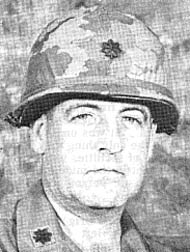 |
Lieutenant Colonel Richard A. Manion of Leavenworth, Kan., recently assumed command of the 1st Battalion, 8th Field Artillery. LTC Manion succeeds Lieutenant Colonel Charles Crowe who commanded the Automatic Eighth since June 1969. |
Tropic Lightning Tots
The Commanding General Welcomes
The Following Tropic Lightning Tots
To The 25th Infantry Division – As
Reported By The American Red Cross.
Born To:
| Jan. 21 SP4 Juan H. Matos, Co A, 2d Bn, 22d Inf, girl PFC Arthur Singleteary, Btry A, 2d Bn, 32d Arty, boy |
Jan. 22 SP4 Michael L. Cornett, Co A, 558th Engr. Bn, girl SP4 Thomas J. Walker, Btry B, 1st Bn, 8th Arty, boy CPT George Wright, 45th Surg. Hosp, girl |
The TROPIC LIGHTNING NEWS is an authorized publication of the 25th Infantry Division. It is published weekly for all division units in the Republic of Vietnam by the Information Office, 25th Infantry Division, APO San Francisco 96225. Army News Features, Army Photo Features, Armed Forces Press Service and Armed Forces News Bureau material are used. Views and opinions expressed are not necessarily those of the Department of the Army. Printed in Tokyo, Japan, by Pacific Stars and Stripes.
MG Harris W. Hollis . . . . . . . Commanding General
MAJ Warren J. Field . . . . . . Information Officer
1LT John Caspari . . . . . . . . . Officer-in-Charge
SGT John Geritti . . . . . . . . . . Editor
SP4 Charles C. Self . . . . . . . Assistant Editor
SP5 Harold Anderson . . . . . Production Supervisor
BATTALION CORRESPONDENTS
| SP4 Dennis Bries SP4 Bill Frame SGT Bill Obelholzer SP4 Jim Williams SGT Wally Baker PFC Andy Trevers SP4 Greg Stanmar SP4 Phil Jackson SP4 Pat Morrison SP5 Tony DeBiasio PFC Rich Fitzpatrick SP4 Jeff Hinman SP4 Doug Sainsbury |
2/22 4/23 4/23 2/12 2/34 1/5 2/14 2/27 3/13 2/12 1/5 2/12 2/77 |
SP4 Ken Barron SP4 Tony Crawford SP4 Greg Duncan SP4 Richard Sears SGT K.C. Cullen SP4 Dan Neff SP4 Henry Zukowski SP4 Brad Yaeger SP4 Frank Rezzonico SP4 Joe O'Rourke PFC Ray Byrne SP4 Robert Caplin SGT William E. Zarrett |
1/8 4/9 2/27 4/9 3/22 7/11 2/22 1/27 1/27 3/4 2/14 4/23 4/9 |
Page 3 TROPIC LIGHTNING NEWS February 9, 1970
Civic Action Wins Friends
ARVNs, 25th Entertain, Help Thai Mai Villagers
By PFC RICH FITZPATRICK
"What have the Viet Cong ever done for you?" was the question Dai Eui Dinh,
Cu Chi District Chief, asked his people at a recent Civic Action meeting in Thai
Mai, a short distance Southwest of Fire Support Base Devin.
"The VC bring booby traps, mines and death - the Allied Forces come with
doctors, agricultural assistance and a new life," he said. "The VC break up
families, force heavy taxes and cause much chaos and sorrow. The Americans are
helping South Vietnam. They bring peace and stability."
Backing up his words with actions, Dai brought two MEDCAP teams, one US the
other ARVN, who worked together to treat 276 civilians. The 25th Division
Support Command joined the festivities by providing transistor radios and a
truck load of clothing and furniture for the Cu Chi District Chief to distribute
to the villagers.
Before the gifts were distributed Dai called a hamlet meeting together where
it was decided who was to receive the contributions. The most needy villagers
were provided for first, then the oldest citizens and finally the largest families.
While the local populace discussed the distribution of the gifts, members of
the District Re-Development Cadre entertained the children with pro-government
songs and games.
When the meeting was over, the people took good advantage of the medcap
services or busily discussed the latest gossip with their neighbors. Musical
entertainment was also provided by the Hau Nghia Province Cultural Drama Team.
Ceremony Shows Security Of Village
By SP4 BOB STEPHENS
DUC HANH A - A combined awards ceremony and civic action project attended by
Brigadier General Thomas Camp, assistant 25th Infantry Division Commander,
recently was held in this small hamlet.
Located between Cu Chi Base Camp and 3d Brigade's forward area at Bao Trai,
Duc Hanh A has long been a haven for hardcore members of the Viet Cong
Infrastructure (VCI), according to Brigade sources. The ceremony was
demonstrative of the new security which has been afforded the area through
pacification projects and combined combat operations.
Soldiers from the Vietnamese Popular Forces were presented Bronze Star Medals
by BG Camp. The PF's were cited for valorous actions during an operation with
3d Brigade forces in which a local VCI was killed.
The 25th Infantry Division crest also was awarded to members of Vietnam's
National Police Field Force for that same action.
Among those receiving awards from the Vietnamese government was 3d Brigade
Commander Colonel Olin E. Smith of McLean, Va., who received the Vietnamese
Cross of Gallantry.
Gallon cans of soy sauce and 50 pound sacks of bolgur were given to needy
families from the area after the awards ceremony. Bolgur is a food staple made
from cracked wheat.
The food was donated by the United States of America Interior Development (USAID),
a US civilian organization which also sponsors education and construction
projects. It works primarily in underdeveloped areas with the help of military
liaisons.
Youngsters from the local elementary school entertained the Division visitors
with a demonstration in the fine art of Karate.
| NEW CLOTHES FOR THE NEEDY - After a meeting to determine who needed new clothing most, Dai Eui Dinh, Cu Chi District Chief, gives clothing donated by 25th Division, Support Command to a worthy villager. (Photo by PFC Rich Fitzpatrick) |
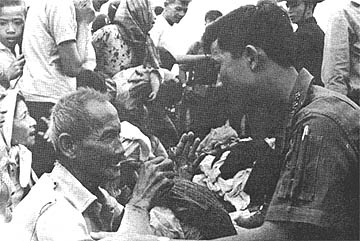 |
Tomahawks Uncover Canal Cache
By SGT. BILL OBERHOLZER
Just after returning from their river operations, Charlie Company Tomahawks
proved they hadn't forgotten their primary infantry role - conducting ground
operations with their armored personnel carriers.
An old French canal, possibly dating back to the 1920's, was the item of
interest for the second platoon of the 4th Battalion (Mech), 23d Infantry as
they rambled along its banks searching for signs of the enemy.
SSG Kim Fisher of Salt Lake City, Utah, said, "We spotted and checked out
plenty of holes along the way. It was about noon when I spotted one that had a
false covering."
SSG Fisher lowered himself into the hole which was about 5 feet deep and 10
feet long and started handing out 8 Chicom anti-personnel mines, 14 handmade
sardine can hand grenades, 7 B-40 rounds, 1 B-41 round, 39 tunnel shovels, 2
75mm recoilless rounds and 7 armor piercing indirect fire heat rounds with a
shape charge on the nose of the munition.
SSG Graham Collins of Columbus, Ohio, added "We found many other places where
a cache could have been kept. I guess they just decided to put all their eggs
into one basket."
The 7 armor piercing indirect fire heat rounds are the first of their kind
ever found in the 25th Division's area of operation.
| ANOTHER AND ANOTHER AND... - Staff Sergeant Graham Collins of Columbus, Ohio, lays out the findings of fellow Tomahawk Staff Sergeant Kim Fisher. (Photo by SGT Bill Oberholzer) |
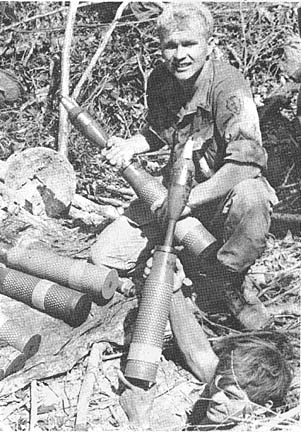 |
Scout Dogs Leading Way
By SP4 FRANK REZZONICO
and
SP4 BRAD YAEGER
CU CHI - Scout dogs help to locate the enemy, warn against booby traps and
mines, and prevent U.S. troops from walking into enemy ambushes.
Since coming from Dau Tieng last June, the 44th Scout Dog Platoon has
performed those missions admirably.
In direct support of the 1/27th Wolfhounds and other units, the dog handlers
spend 20 days per month in the field, usually walking point for an infantry
unit. There are 19 dogs in the platoon.
While in Cu Chi, the dogs are kept fit by running through a specially
designed exercise yard. The big German Shepherds average 80 pounds in weight
and their powerful jaws can generate 750 pounds per square inch of force. Each
dog has a separate "personality," and some are vicious, depending on the
treatment they received during training at Ft. Benning, Ga. Dog and handler
undergo training together when they arrive in Vietnam, and each handler remains
with his original dog.
First Lieutenant Jerry L. McLendon of Columbia, Ala., commander of the
platoon says, "We have never had a U.S. unit walk into an enemy ambush when one
of our dogs has been along."
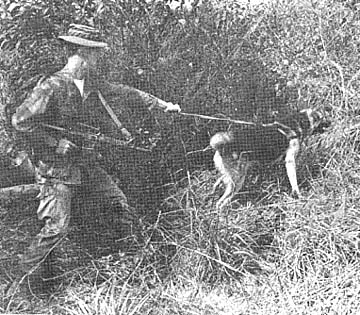 |
ALERTING TO THE ENEMY - Scout dog Lucky, handled by SP4 Edward Bollen of Yonkers, N.Y., alerts at signs of the enemy near a bunker complex. |
Page 4-5 TROPIC LIGHTNING NEWS February 9, 1970
All Phases Of Civil Affairs
Warriors Get With PSYOPS Program
By SP4 JEFF HINMAN
FSB PERSHING - Civic Affairs Project is a term we all hear nearly every day
of our tour in Vietnam. But how many of us ever stop to think what these
important words mean to us and the Vietnamese people?
It means gaining the support of the civilian population for the government of
the Republic of South Vietnam. It also means convincing the enemy, VC and NVA,
that their cause is hopeless and in the end they will suffer defeat and to rally
to the side of the government.
According to the 2nd Brigade, Psychological Operations and Civic Affairs
Officer, First Lieutenant Anthony Q. Faiia of Charleston, S.C., "We try to get
the support of the District Chiefs for our programs. Having a civilian leader's
assistance is a great help in our efforts to reach the people."
Faiia continued, "Our civic affairs programs include medical assistance
missions, MEDCAPS and NIGHTCAPS in the evening, also audio-visual programs
throughout the Brigade area of operations."
"In the 2nd Battalion, 12th Infantry's area of operations alone an average of
750 people are treated each week," said Captain Burke Smith of Oak Park, Ill.,
the Warrior Battalion Surgeon. "It shows the people we really do care."
The PSYOPS directed against the enemy in the field consist of leaflet drops
from helicopters and airborne speaker broadcasts called "Squawk" missions which
are flown day and night throughout the 2nd Brigade. Taped messages of enemy who
have rallied and leaflets giving safe conduct and describing the benefits of the
Chieu Hoi program are distributed to bring in the Hoi Chanhs and bring the end
of the war a little bit closer.
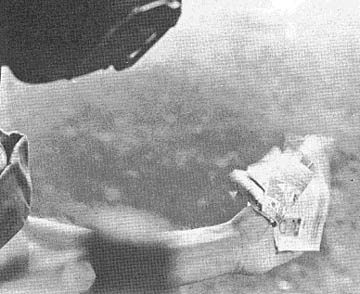 |
THIS IS WHERE it all begins. Safe conduct passes and Chieu Hoi leaflets are dropped from a LOH after sniffer machine gets a reading from below. (Photo by SP4 Jim Williams) |
| ALL EYES are glued on Warrior Surgeon Captain Burke Smith, Oak Park, Ill. as he tests a patient for tuberculosis. (Photo by SP4 Jeff Hinman) |
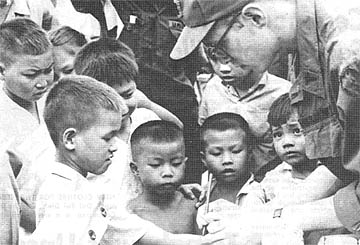 |
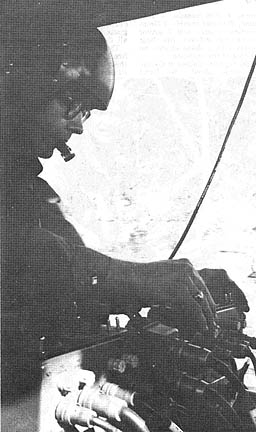 |
SNIFF MISSIONS are all part of the Warrior PSYOPS program. When the enemy is detected leaflets are dropped, thus putting the entire PSYOPS movement into effect. (Photo by SP4 Jeff Hinman) |
| MINOR CUTS and bruises are taken care of as a large part of the job for Warrior Surgeon Captain Burke Smith. (Photo by SP4 Jeff Hinman) |
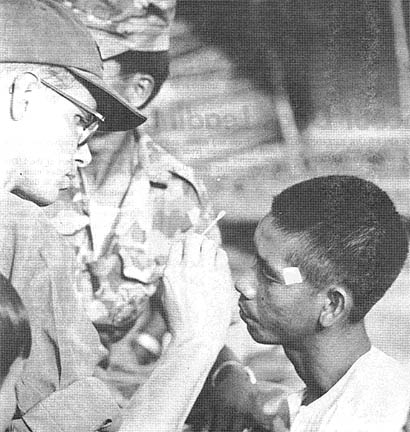 |
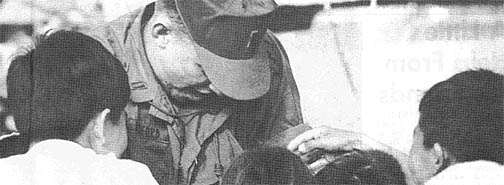 |
A storm of children greet Warrior Civil Affairs Officer Lieutenant William Radford as he hands out toothbrushes and dental cream near Fire Support Base Pershing. (Photo by SP4 Jeff Hinman) |
| SOUND CHOPPER CIRCLES a contact area with speakers roaring a chieu hoi message. This, combined with MEDCAPS and leaflet drops deter enemy action. (Photo by SP4 Jeff Hinman) |
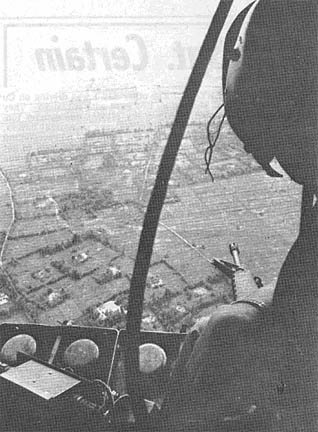 |
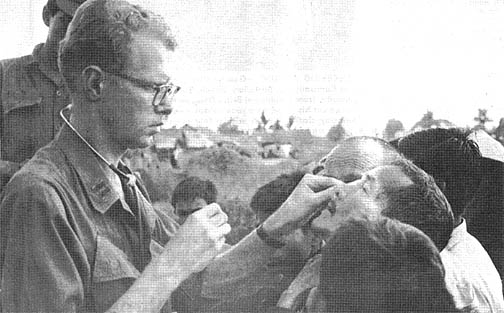 |
A LITTLE DAB will do ya' as Captain Smith administers first aid for an eye infection during a 2d Brigade PSYOPS program. (Photo by SP4 Jeff Hinman) |
| A HELPING HAND from Nurse Ba and medic Loc to the Warriors in treating the people on a night cap mission near Trang Bang. (Photo by SP4 Jeff Hinman) |
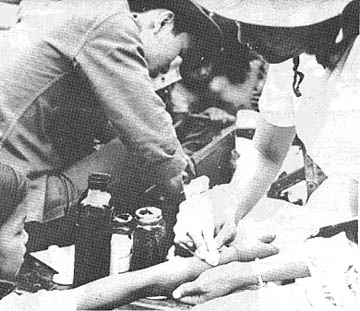 |
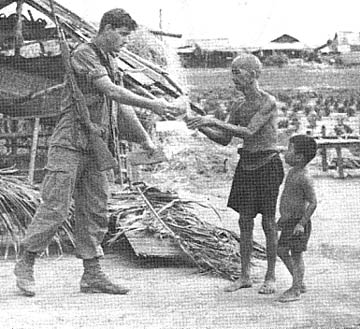 |
SOUTH VIETNAM FLAGS are distributed to the local population near Fire Support Base Pershing by Warrior Sp4 Donald West of Culver, Tex. as part of the PSYOPS program in Trang Bang. (Photo by SP4 Jeff Hinman) |
| HOI CHANH who just rallied to the Warriors shows his unit's location to Charlie Company Commander Captain Michael Neuman and his interpreter. The Chieu Hoi program is enhanced by MEDCAPS and NIGHTCAPS by the Warriors. (Photo by SP4 Jeff Hinman) |
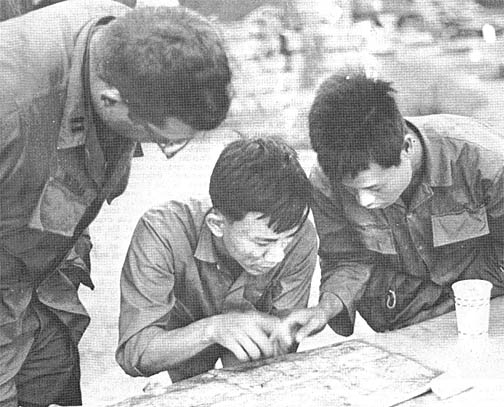 |
Page 6 TROPIC LIGHTNING NEWS February 9, 1970
A Little Help From His Friends
By SGT. WALLY BAKER
FSB BUELL - Help came when it was most needed as SP4 Sammy Nugent of
Headquarters Company, 2nd Battalion, 34th Armor can tell you.
Specialist Nugent of Harrisonburg, La. was called home on special leave
recently but to his horror discovered he was short of money for his trip from
Oakland to his home.
Hearing of this his fellow reconnaissance scouts from his platoon chipped in
and came up with enough money for him to make the trip.
First Sergeant Frank Partyka from Killeen, Texas, explained, "hell, these
scouts will do anything for each other - they really stay close."
| MONKEYING AROUND - George (the monkey) the mascot of Delta Company 4th Battalion, (Mech) 23rd Infantry gets a little sympathy from Lieutenant Brian Dougherty of Bellevue, Wash. George cut his hand on a razor blade and the medics of Delta Company closed the cut with a few sutures. A plaster cast kept George from chewing on the stitches. (Photo by SP4 Robert Caplin) |
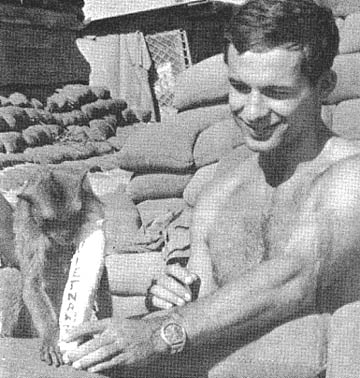 |
VC Attack Village, S-5 to the Rescue
By SP4 DENNIS BRIES
FSB HOUSTON - A VC attack on the small village of Lap Dien about 5 miles
southeast of here in Duc Hue District called for fast and decisive action on the
part of Triple Deuce and Vietnamese Forces.
After the VC left the village an ARVN ambush patrol spotted the enemy unit.
The patrol killed one and captured another.
CPT Willie F. Black, 2/22 S-5 from Columbus, Ga. acted fast with an emergency
MEDCAP operation in the village the next morning. Extra medicine, soap and a
variety of PSYOPS leaflets were passed out to the villagers. Also a number of
Chieu Hoi passes and information leaflets were left with villagers and scattered
along the VC trail to and from the village.
ACCORDING TO BLACK, "The villagers were a little slow in responding to our
call but as the medcap progressed, some of the older people came to see us.
Real progress has been made in winning the people of Lap Dien since my first
visit several weeks ago."
Kit Carson Scouts who also serve as interpreters mingled with the villagers
and visited many of the local residences gathering intelligence on the enemy
unit which had entered the village the previous evening.
Since Lap Dien is a Catholic village the 3d Brigade Chaplain (Captain)
Anthony V. Rodrigues accompanied the team on this trip. Chaplain Rodrigues
passed out a number of rosary beads and religious medals. Black said, "The chaplain helps me and my team to
better identify with the villagers here than say a village which is
predominantly Buddhist or Cao Dai."
SP5 RILEY NEDLA, team medic from Albion, Neb. said, "I enjoy my work.
There's usually more than enough patients to keep me busy during our visits."
'Oldtimer' Finally A Shortimer
By PFC ANDY TREVERS
CU CHI - Like many other Tropic Lightning soldiers now serving in Vietnam
Sergeant First Class Jack Cassiba of Linden, N.J. will DEROS this year. Most
G.I.'s, however, have been waiting 12 months, but Cassiba has waited over four
years to become a short timer!
Cassiba has served with the 1st Battalion (Mechanized), 5th Infantry in
Vietnam since December 1965. During that time Cassiba has performed duties as
mess sergeant and has literally prepared thousands of tasty meals for the hungry
Bobcats.
There are a number of reasons why Cassiba has made Vietnam the longest tour
of his Army career. Cassiba explained some of them, "At the end of each of my
tours here I would receive orders for an assignment that didn't appeal to me so
I decided to extend."
Cassiba's first assignment, for example, was a missile site in North Dakota.
"It's way too cold up there for me," Cassiba said. "I'd rather stay here in
Vietnam where its warm all the time."
Cassiba also gave another reason for his long stay in Vietnam, "To me this is
my job, I like it and I like the pay I receive."
Cassiba was with the 1st Battalion (Mechanized), 5th Infantry before the
Battalion came to Vietnam. In all he has served with the Bobcats for eight
years.
To the dismay of all the well fed Bobcats, Cassiba will DEROS this spring,
and return to Hawaii for his next tour of duty.
Ask Sgt. Certain
DEAR SERGEANT CERTAIN: The other day I was driving on Cu Chi base camp and
was stopped by two guys with clipboards. They pulled me over and wanted to
inspect my M151A1 one quarter ton, one each. After noting several deficiencies
such as no seat covers, no spare tire cover, no witty saying on the front, and
no raccoon tail or state flag on the antennae, he sent me to the motor pool to
get them corrected. Is there anything you can do about this? Do you know how
hard it is to get a raccoon tail here?
P.
Jones
DEAR JONESY: Yes I do know how hard it is to get accessories for vehicles in
Vietnam, that's why I've been thinking about opening Sergeant Certain's Speed
Shop. In addition to stocking raccoon tails and most of the state flags, with
the exception of Montana and Idaho, it will feature such items as anodized wheel
covers, leopard skin seat covers, an M151A1-3B37 glass pack muffler, a steering
wheel cover made from dried, cured rice cakes. For the sporty set, there will
be a pin-striped candy colored completely washable convertible top available for
vehicles under two-and-a-half tons (with optional OD fringe). The speed shop
will also feature an attachable aluminum retractable combination carport/patio
for APCs and tank. Of course we will have the usual assortment of items for the
mirrors such as shrunken heads, dice, an eight ball for the gear shift and a
genuine imitation water buffalo tail for the gas tank, to fool your friends.
That should get you through any inspection line.
Page 7 TROPIC LIGHTNING NEWS February 9, 1970
ANC's 69th Anniversary
Army Nurses: Here to Heal
By SP4 TOM BOZZUTO
CU CHI - The Army Nurse Corps celebrates its 69th anniversary this week.
The young men and women who serve, often without much recognition, are all
volunteers. The primary bond among them is their desire to help their fellow
men, especially those men whose job it is to fight in their country's armed
forces.
In Cu Chi, the 59 nurses who staff the 12th Evacuation Hospital, work 12
hours a day, 6 and sometimes 7 days a week. Back in the states, they would work
no more than 8 hours a day, 5 days a week.
There, they would also have the advantages of all the latest medical
equipment to deal with patients who, though they may be seriously ill, are
seldom as difficult to treat as the GI who has been wounded. In fact, according
to one of the nurses at 12th Evac., Captain Patsy Weaver, one of the main
reasons she came to Vietnam was "because of the experience one could get from
treating battle-inflicted wounds."
Captain Weaver also feels that the morale among the nurses "is high,
considering the long hours and the variety of illnesses treated."
Lieutenant Colonel Helene Carrol, head nurse at 12th Evac. said, "For the
first three weeks a young nurse may find it a little hard to adjust to the field
hospital environment." But within six weeks, after a well thought out and
extensive orientation period, almost all of the nurses have "matured
tremendously."
The nursing staff at the hospital live under pretty much the same conditions
as any other GI in Vietnam. They live in a small area within Cu Chi base camp,
and leave the camp only two or three at a time for a weekly MEDCAP in the Cu Chi
sub-sector.
There are two things however, besides the fact that most of them are women,
that make the nurses' life in Vietnam a little different than that of the
average soldier. First, the reward for their efforts is easily visible. First
Lieutenant Diana J. Doyle of Brainard, Minn., who has a B.S. in nursing from the
University of Minnesota, said "when you are working in the busiest hospital in
Vietnam you naturally feel like you're doing a worthwhile and rewarding job."
Miss Doyle also said that as a woman and a nurse she felt that she is now "in a
position where her services are most essential," and where she is doing the most
good.
The second difference between a nurse's life and that of the combat soldier
is that she or he is performing a job which, prior to entering the service, had
chosen as a profession.
|
Photos by |
| Captain Patsy Weaver feels that the morale among the nurses is very high despite the long hours and constant demands faced each day. |
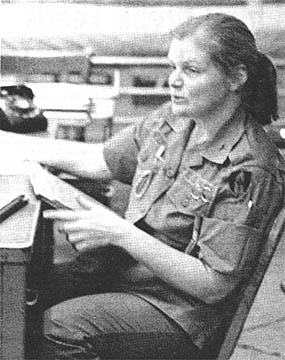 |
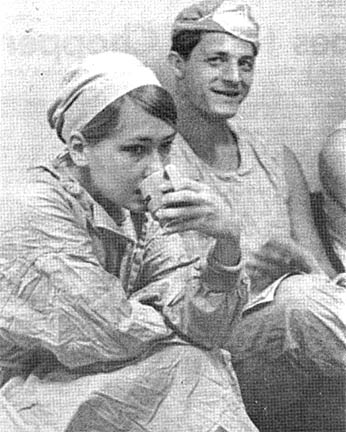 |
Lieutenant Sue Kramer and Specialist 4 Irv Herb take a well deserved break in the endless tasks at 12th Evac Hospital. |
| Lieutenant Nancy Runk comforts a patient with a warm smile and friendly visit. |
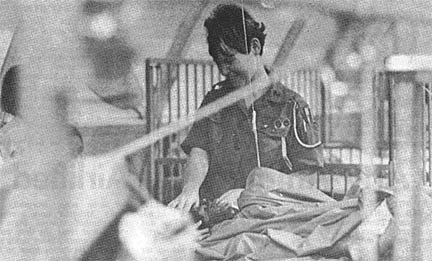 |
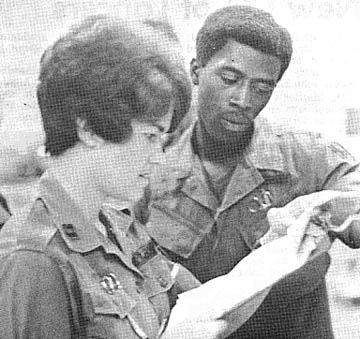 |
Captain Marilyn Ashton and Specialist 4 Jesse Hutcheson check over a patient's progress report. |
| Captain Dorothy Bleck reaches a bottle of plasma for a patient. |
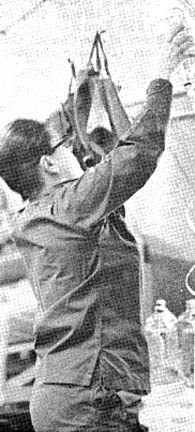 |
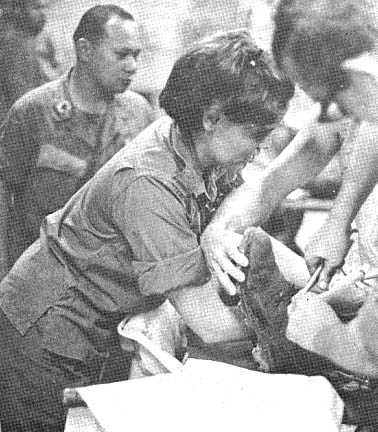 |
Lieutenant Gail Clark treats an emergency patient. |
Page 8 TROPIC LIGHTNING NEWS February 9, 1970
Chow Break Leads To Explosives Find
By SP4 TONY D. CRAWFORD
Recently the weapons platoon of Charlie Company, Manchus, took a chow break
and uncovered a large cache of mines, grenades, and mortar rounds. The 4th Battalion, 9th Infantry platoon had been participating in multiple
eagle flight insertions all morning in the southeastern tip of the Renegade
Woods. About noon they decided to stop for a lunch break.
"We had just stopped for chow and I was spreading my men out for security
when an NVA helmet and several Chi Com grenades were found," said Platoon Leader
First Lieutenant Kenneth Banta of Clovis, Calif.
Soon afterwards Specialist 4 Ronald M. Vmentum of Green Bay, Wis., discovered
19 anti-tank mines. Vmentum remembered sitting down and then seeing what seemed
to be a metal object under a clump of bushes.
"I was curious as to what it was, so I went over to check it out," he said.
"At first I was afraid of a possible booby trap." He carefully removed the
bushes and found the mines.
The platoon was then organized into search parties and began looking over the
area for other finds. Sergeant Gary L. Comstock of Walnut, Kan., said that
during the search "we had to be extremely careful because booby traps were
suspected, but luckily none were found."
Private First Class Bill Massey of Bridgeport, Ala., remembered the search as
"fantastic." "Everywhere we looked we kept finding munitions - behind bushes,
in holes, covered with grass - everywhere!"
The search turned up 57 anti-tank mines, 214 Chi Com grenades, 3600 AK
rounds, 10 82mm mortar rounds, 22 cans of charges, and extraneous personal gear.
Regulars Kill Enemy Caught In Own Camp
By SP4 BRIAN FLAHERTY
TAY NINH - NVA troops were apparently surprised when Bravo Company, 3d
Battalion, 22d Infantry, showed up at their small perimeter uninvited. The
point men were keen enough to take notice and commence the action that resulted
in 22 enemy dead.
While conducting ground operations near the Cambodian Border, "B" Company
spotted approximately 50 NVA soldiers dressed in all sorts of uniforms: cowboy
hats, helmets, black pants, mixed colored shirts, colored scarfs and assorted
web gear.
Bravo Company, under the direction of Captain Daniel McCormack opened fire,
while the RTOs called for gun-ships and Artillery. Specialist 4 Robert
Hutchins, an RTO, said later "our coordination with gunships and artillery was
flawless."
The NVA Troops feeling the pressure started their retreat to the Southwest,
exposing themselves to the Regular's fire. McCormack, in close pursuit with his
men, found a total of 22 NVA bodies.
| FOLLOW THE 'MAX BRINGER' - Fire Brigade infantrymen of the 3d Squadron, 4th Cavalry, ride slicks following a Cobra gunship softening up their landing zone before insertion for an operation in the Ho Bo Woods. (Photo by SP4 Joe O'Rourke) | 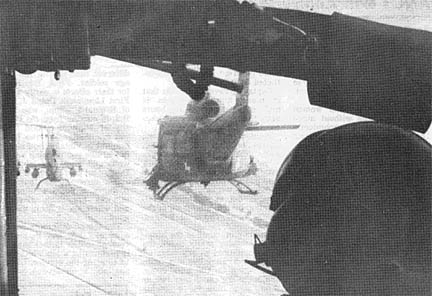 |
Veteran of Two Armies
Briton Hopes to Fly Chopper
By PFC RAY BYRNE
FSB PATTON - Not many of the Golden Dragons of the 2nd Battalion, 14th
Infantry, can claim to be veterans of two campaigns in two different armies, but Glyn Eatwell of Cwmcarn Monmouthshire, England, can.
Eatwell's military service began almost five years ago when he joined the
British Army. He became a Red Beret, an outfit similar to the Army's Special
Forces.
Eatwell saw his first combat action in Malaya in 1966. The Malaysians were
fighting guerilla forces infiltrating from Indonesia and Eatwell served as an
advisor to the Malaysians.
"The fighting in Malaya, now called Malaysia, was strikingly similar to the
type the United States is now doing in Vietnam," he said.
After leaving Malaysia, Eatwell served in Aden of the United Arab Republic
and as an advisor in Israel. In 1968, while a private citizen in England, he
decided he wanted to be a helicopter pilot. So on Oct. 3, 1968, he landed at
Kennedy International Airport in New York intending to become a pilot with the
United States Army.
Eatwell's hope of becoming a helicopter pilot was cut short by an Army
regulation requiring all pilots to be United States citizens. But because of
his past military experience he joined the Army as an infantryman and was
shipped to Vietnam without having to go through any basic or advanced Army
training.
Now in his 11th month with "C" Company of the 2nd Battalion, 14th Infantry,
Eatwell is a short timer and he hasn't lost his desire to become an Army
aviator. After his DEROS he plans to fly to Hawaii to become a United States
citizen, then it's on to Warrant Officer Flight Training to finally get his
aviator's wings.
Eatwell said his long range plan is to return to Israel and work as a
commercial helicopter pilot. "Israel is one of the most beautiful places in the
world, and I dream of one day living there in peace," he added.
After five years of military life, Eatwell's enthusiasm and motivation have
not diminished. And when he becomes a pilot, his greatest wish will have been
fulfilled. He enjoyed being an infantryman, he says, but flying has long been
his dream.
Arty Ammunition Airlifted
BY SGT BILL OBERHOLZER
FSB HUNTER - Charlie Company Tomahawks recently received 12 tons of 105 HE
artillery rounds outside their perimeter.
It was friendly fire, however, as the 8th Aerial Port Combat
Control Team coordinated
the heavy artillery drop for C Battery, 7th Bn., 11th Field artillery, operating
out of the 4th Battalion, (Mech) 23rd Infantry's FSB Hunter.
Members of the Combat Control Team (all jump qualified) parachuted from their
C130 Transport, landing in a field adjacent to FSB Hunter. This was to be the
drop zone for the artillery.
"It was our job to set up air control measures within a certain
radius and distance from the drop zone. We also coordinated with friendly artillery fire
in the area," said Air Force Staff Sergeant Robert Phillips of Fall River, Kan.
The team established communication from the ground with the loaded aircraft
and prepared the drop zone. Normally an Army Airborne unit precedes the combat control
team to sweep and clear the drop zone. Then the control team lands and performs
its duties prior to the all important drop.
The mission's objective was to show the practicality of resupply utilizing
aircraft, when possible, rather than by truck convoy. Resupply by aircraft is a
much quicker and cheaper way of transporting weighty necessities to the fire
support bases and to other out of the way places.
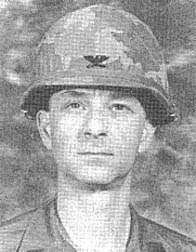 COL Mueller Named New CO of Lancers
COL Mueller Named New CO of Lancers
TAY NINH - Colonel Paul J. Mueller, Jr., recently assumed command of the 1st
Brigade, 25th Infantry Division here from Colonel John E. Tyler.
COL Mueller's most recent assignment was in the Pentagon where he served in
the Office of the Comptroller of the Army.
The new Commanding Officer of the Lancers entered the Army in June 1950 when
he was commissioned a second lieutenant upon graduation from West Point. His
first assignment was with the 82nd Airborne Divison. He subsequently served
with the 16th Infantry, 1st Infantry Division. In Germany, COL Mueller
commanded the 2nd Battalion, 7th Infantry, 3rd Infantry Division in 1965 and
1966.
On his first tour of South Vietnam in 1967 and 1968, COL Mueller was the
Province Senior Advisor for Lam Dong Province in II Corps.
Born in Washington D.C., he has a Bachelor of Science degree from the United
States Military Academy and graduated from the Army War College in 1967.
COL Tyler, who commanded the 1st Brigade from August 1969 until January 1970,
is now the Senior Adviser for the 18th ARVN Division in Xuan Loc.
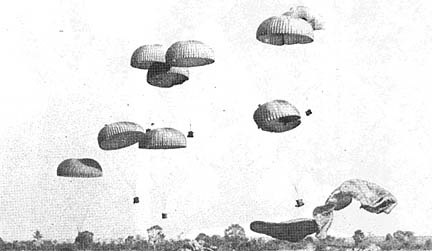 |
AMMO VIA AIR - Twelve tons of 105 mm HE artillery rounds come to rest outside Fire Support Base Hunter near Tay Ninh City. They were dropped to demonstrate the practiciality of resupply by aircraft. (Photo by SGT Bill Oberholzer) |
Thanks to:
Roger Welt, 4th Bn., 23rd Inf., and a Tropic Lightning News correspondent,
for sharing this issue,
Kirk Ramsey, 2nd Bn., 14th Inf. for creating this page.
This page last modified 03-30-2006
©2006 25th Infantry Division Association. All rights reserved